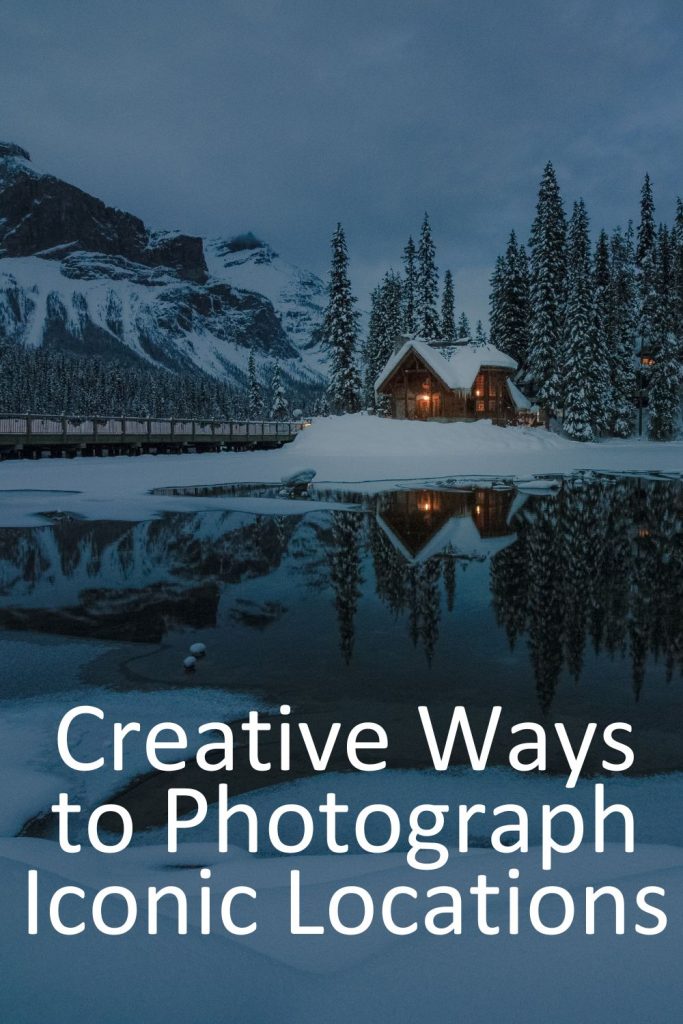
We’ve all been there. You finally arrive at that world-famous spot, the overlook, the waterfall, the desert butte, and as soon as you pull out your camera, you realize you’ve seen this photo a thousand times before.
The same angle. The same light. The same composition that floods postcards and Instagram feeds. Suddenly the excitement gives way to doubt: How can I possibly create something unique here?
The truth is, you can. To connect with over-photographed locations, you need to shift your approach. Instead of chasing the same “iconic shot,” focus on fresh perspectives, mindfulness, and seasonal changes.
When you connect more deeply with a place, your photographs begin to reflect not just what it looks like, but how it feels to you.
I receive commissions from links in this post, thank you for your support
Reconnect with Popular Photography Spots
How to Photograph Iconic Locations Differently
The first step in moving beyond clichés is to stop rushing to the “classic view.” Those well-worn spots are popular for a reason, but they rarely tell the full story of a landscape.
I will make a point of capturing the “typical” iconic view at a well known location so that I can put my mind at ease knowing I have “a” good shot. I will then move on and use the following four techniques to photograph iconic locations differently.
Change your timing
Midday shots are often harsh and flat. Arrive before sunrise or stay long after sunset to capture moodier, softer light. Low light and night photography at landmarks can reveal a whole new personality.
Vary your perspective
Drop low to the ground to emphasize foreground textures, or climb higher if access allows. Sometimes just a few feet to the left or right creates a completely new frame.
Play with focal length
Wide-angle lenses capture grandeur, but telephoto lenses isolate hidden details. A lone tree on a mountainside or a repeating pattern of dunes can be as powerful as the full panorama.
Seek out hidden stories
Instead of focusing only on the “big picture,” notice smaller vignettes: cracks in ancient stone, shifting light through fog, or the way a river curves around a bend. Try abstract frames at your location for a new fresh take on the location.
These shifts don’t just make your images different—they make them yours.
Discover Your Next Journey – These Tours are designed for people who connect with light and landscape.
Finding Fresh Perspectives in Landscape Photography
Freshness comes not from reinventing the wheel, but from deepening your vision. Ask yourself: What does this place mean to me? What am I noticing that others may overlook?
- Move slowly: Don’t just snap and go. Walk the area, let your eye wander, and follow curiosity.
- Use weather to your advantage: Fog, storms, rain, or snow transform even the most photographed spot. A famous canyon becomes mysterious under cloud cover; a waterfall glows when framed by autumn mist.
- Experiment with techniques: Long exposures, intentional blur, or black-and-white processing can refresh familiar subjects. Try under or over exposing for a high key or low key look. The goal isn’t gimmicks—it’s finding ways to align the photo with the mood you’re experiencing.
Remember, landscapes are never truly the same twice. The air shifts, the light evolves, the seasons turn. Your perspective at that moment is inherently fresh.
Photographing Famous Places Creatively
When visiting well-known destinations, creativity often comes from embracing limitations. Instead of feeling trapped by the “must-have shot,” see it as a starting point. Once you’ve captured it, challenge yourself: Now what else is here?
Look behind you
Some of the most overlooked photographs happen when you turn away from the famous view.
Include people sparingly
Adding a human figure can convey scale or emotion; just make sure it serves your story.
Break rules intentionally
Tilt the horizon, crop aggressively, or highlight shadows instead of highlights. These creative compositional risks make space for originality.
Photography is as much about expression as it is about documentation. When you let go of trying to “compete” with existing images, your creativity has room to breathe.
📸Learn for free!
➡️ FREE Wallpapers and Guides
➡️ DISCOUNTS on future Tours & Tutorials
➡️ TIPS for improving Your photography

I don’t share your Info with anyone. You can unsubscribe at anytime.
Mindfulness in Landscape Photography
One of the most powerful ways to reconnect with over-photographed locations is through mindfulness. Instead of seeing the site as an object to capture, treat it as a living presence to connect with.
- Pause before you shoot: Breathe. Listen to the sounds around you; the wind, birds, distant water. Let the atmosphere guide your choices.
- Use all your senses: Photography is visual, but mindfulness draws in touch, smell, and sound. That sensory richness translates into more layered, evocative images.
- Shift from ownership to relationship: You’re not “taking” a photo; you’re co-creating with the land. This perspective aligns with eco-spiritual practices like forest bathing (shinrin yoku), where slowing down deepens awareness.
When practiced this way, even the most famous sites like Monument Valley, Yosemite, or the Grand Canyon, become fresh again. They’re not just symbols. They’re living landscapes with whom you’re in dialogue.
Seasonal Perspectives on Iconic Landscapes
One of the simplest yet most overlooked ways to break free of clichés is to return to the same location in different seasons.
- Winter: Snow softens lines, transforms color palettes, and emphasizes contrast. A crowded summer viewpoint may be nearly empty in January, with a whole new mood.
- Spring: Waterfalls surge, meadows bloom, and misty mornings abound. Photographs feel alive with renewal.
- Summer: Long days and dramatic skies invite golden hour explorations. Harsh midday sun can still be creative with silhouettes or shadows.
- Autumn: The fiery palette of changing leaves adds drama and depth, transforming the familiar into the extraordinary.
This cyclical approach mirrors the Wheel of the Year, reminding us that nature is not static. Each season and the Four Elements brings opportunities to see even the most photographed landscapes in a new way.
Conclusion
To connect with over-photographed locations is not about outsmarting other photographers or finding the one untapped angle. It’s about slowing down, being present, and letting your unique relationship with the land come through.
The most memorable images aren’t the ones that compete with postcards. They’re the ones that reflect your presence, your perspective, and your reverence for the moment.
📸Learn for free!
➡️ FREE Wallpapers and Guides
➡️ DISCOUNTS on future Tours & Tutorials
➡️ TIPS for improving Your photography

I don’t share your Info with anyone. You can unsubscribe at anytime.
- Reconnect with Popular Photography Spots
- How to Photograph Iconic Locations Differently
- Finding Fresh Perspectives in Landscape Photography
- Photographing Famous Places Creatively
- Mindfulness in Landscape Photography
- Seasonal Perspectives on Iconic Landscapes
- Conclusion
- FAQs: Avoiding Clichés in Landscape Photography
- 📸Learn for free!
- 📸Learn for free!
FAQs: Avoiding Clichés in Landscape Photography
How can I avoid cliché photos in landscape photography?
Slow down, explore different perspectives, and focus on your emotional response rather than replicating what you’ve seen online.
What are creative tips for photographing iconic places?
Try unusual focal lengths, embrace different weather, and revisit locations during off-peak hours or seasons.
How do I connect with a location through photography?
Practice mindfulness, journal your impressions, and let curiosity guide your compositions rather than chasing the “famous shot.”
How can I make my travel photos unique?
Focus on small details, seasonal changes, and personal stories from your journey. The more personal the perspective, the more unique the image.






